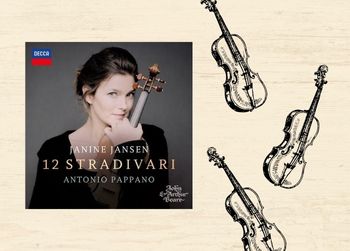When the COVID-19 pandemic curtailed and restricted concert activity in 2020 and 2021, many artists developed unique recording projects that could go ahead in the new circumstances. One example of these innovative turns is Dutch violinist Janine Jansen’s new album, 12 Stradivari. The adventure with twelve exquisite and extremely valuable violins made by Antonio Stradivari in the late seventeenth and early eighteenth centuries was the idea of Steven Smith, managing director of the internationally renowned fine violin dealers J. & A. Beare. Smith saw the opportunity to bring together a dozen of the world’s best violins by Antonio Stradivari on one recording and approached Jansen (who currently performs on the 1715 Shumsky-Rode Stradivarius) to curate the recording in collaboration with pianist Antonio Pappano. The result is a fascinating exploration of twelve unique instruments, each with its own extraordinary associations with many of the leading violinists of the last three centuries. Jensen’s selection of repertoire reflects the history of the violins, while also highlighting the differences in the sound and personality of each instrument.
This post explores Jansen and Pappano’s 12 Stradivari, and introduces some of the other recordings in the WCL collection that feature instruments from Stradivari’s Cremona workshop. To find out more about the history of the instruments, and how they were made, have a look at the excellent Tarisio site as well!
12 Stradivari
Jansen chose the repertoire for this recording to align with the history of the twelve violins and the musicians who played them. For the music of Fritz Kreisler, she plays his Syncopation on the 1734 ‘Lord Amherst’ violin, and his Liebesleid on the 1733 ‘Huberman’ violin, both of which were Kreisler’s instruments. Jansen plays the ‘Haendel’ Stradivari — the instrument long associated with the inimitable Ida Haendel (1924-2020) — in the first of Karol Szymanowski’s Mythes, op. 30, ‘La Fontaine d’Aréthuse’, a work that Haendel recorded in 1996. For Henri Vieuxtemps’ Romances sans paroles, op. 7, Jansen chose the 1710 ‘Vieuxtemps’ Stradivari on which the Belgian virtuoso performed between 1870 and 1881. Jansen’s choice of a variety of short character pieces and transcriptions provides a portrait in miniature of each violin, while also demonstrating her own artistry in both the well-known and rarer works she plays. Pappano’s stylish playing complements Jansen, in an intuitive partnership.
Violin concertos 2 & 4 Sinfonia concertante / Mozart, Wolfgang Amadeus
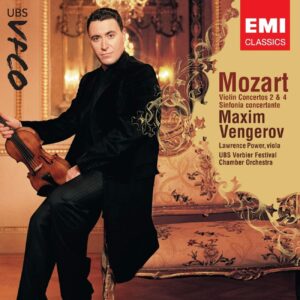 In this recording, Maxim Vengerov plays the 1727 ‘Kreutzer’ Stradavarius (you can read more about his connection with this violin here). Violist Lawrence Power also plays beautifully in the Sinfonia Concertante, and the UBS Verbier Festival Orchestra makes a stylish contribution. Both Vengerov and Power offer rich, yet subtle, interpretations of Mozart, emphasizing the lyricism and wit of each piece. The central Andante of the Sinfonia Concertante is a particular highlight, while it’s also gratifying to hear Mozart’s Violin Concert No. 2 in G major, which is too rarely performed or recorded.
In this recording, Maxim Vengerov plays the 1727 ‘Kreutzer’ Stradavarius (you can read more about his connection with this violin here). Violist Lawrence Power also plays beautifully in the Sinfonia Concertante, and the UBS Verbier Festival Orchestra makes a stylish contribution. Both Vengerov and Power offer rich, yet subtle, interpretations of Mozart, emphasizing the lyricism and wit of each piece. The central Andante of the Sinfonia Concertante is a particular highlight, while it’s also gratifying to hear Mozart’s Violin Concert No. 2 in G major, which is too rarely performed or recorded.
Violin concertos / Beethoven, Ludwig van
Another opportunity to hear Jansen, this time playing the ‘Barrere’ Stradavarius (1727) in Beethoven’s Violin Concerto in D, and Benjamin Britten’s Violin Concerto. The pairing of these two works is unusual, but it had been a longstanding desire of Jansen to present them in one recording, and the result is compelling. In Beethoven’s Concerto, she plays with lyricism and precision, exploring the gentle moments of the first and second movements with particular poetry. The finale, in contrast, is buoyant and joyous, exulting in the dialogues between soloist and orchestra. Likewise, in Britten’s Concerto, Jansen and the orchestra are true partners, working together to emphasize the tension that permeates this work.
1930s violin concertos. Vol. 1
The first volume of Gil Shaham’s 1930s Violin Concertos is an opportunity to hear the 1699 ‘Countess Polignac‘ Stradavarius, as well as five violin concertos from a turbulent decade. The concerti by Barber, Berg, Britten, Hartmann, and Stravinskhy reveal the diverse paths taken by these modernists. In addition, Shaham plays each piece with a different orchestra: Barber with the New York Philharmonic, Berg with the Staatskapelle Dresden, Hartmann with the Sejong Soloists, Stravinsky with the BBC Symphony Orchestra, and Britten with the Boston Symphony Orchestra. As an opportunity to hear a fine violinist play with several of the world’s leading orchestras, this recording is unrivalled.
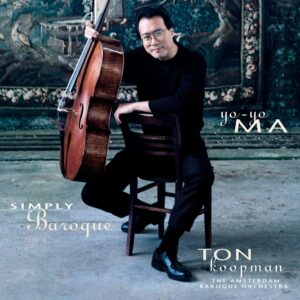 Simply baroque / Ma, Yo-Yo
Simply baroque / Ma, Yo-Yo
Yo Yo Ma has played the ‘Davidov’ Stradivarius cello – previously one of Jacqueline du Pré’s instruments – since the late 1980s. The instrument is named for Karl Yulievich Davydov (1838-1889), whom Tchaikovsky once dubbed ‘the czar of cellists’. Initially, Ma used the ‘Davidov’ primarily for baroque and classical repertoire, including this collaboration with Ton Koopman and the Amsterdam Baroque Orchestra. Here, Ma performs several arrangements and transcriptions of popular extracts from Bach’s cantatas. ‘Erbarme dich’ from the St Matthew Passion works particularly well, as does the ‘Air’ from Bach’s Orchestral Suite No. 3. However, Ma’s performances of Luigi Boccherini’s cello concerti in G major (G. 480) and D major (G. 478) are the highlights of the disc, two galant works that Ma explores with drama and sensitivity.
Sonatas for fortepiano and violin. Vol. 3, K. 302, 377, 379 & 454 / Mozart, Wolfgang Amadeus
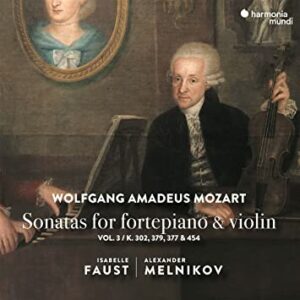 Isabelle Faust plays the ‘Sleeping Beauty’ Stradavarius in this recording of four sonatas for keyboard and violin. Alexander Melnikov’s instrument is a fortepiano by Christoph Kern modelled on an Anton Walter instrument of 1795. The ‘Sleeping Beauty’ has an especially fascinating history, as Alessandra Barabaschi explains. In the third volume of their journey through Mozart’s sonatas, Faust and Melnikov perform the Sonata in E-flat major K. 302 (which Mozart composed in Mannheim in 1778 and dedicated to Maria Elisabeth, the Electress Palatine); the Sonatas K. 377 and 379, in F major and G major (composed and published in Vienna in 1781 and dedicated to Mozart’s piano pupil Josepha Auernhammer); and the Sonata in B-flat major, K. 454. Mozart wrote K. 454 for Italian virtuosa Regina Strinasacchi who was then touring Europe. At their concert, in Vienna’s Kärntnerthor Theater on 29 April 1784, Mozart had not yet committed the piano part of the Sonata to paper, and performed it from memory. Faust and Melnikov play with panache and humour. The timbre of the fortepiano and the resonance of the ‘Sleeping Beauty’ complement each other in an ideal fashion.
Isabelle Faust plays the ‘Sleeping Beauty’ Stradavarius in this recording of four sonatas for keyboard and violin. Alexander Melnikov’s instrument is a fortepiano by Christoph Kern modelled on an Anton Walter instrument of 1795. The ‘Sleeping Beauty’ has an especially fascinating history, as Alessandra Barabaschi explains. In the third volume of their journey through Mozart’s sonatas, Faust and Melnikov perform the Sonata in E-flat major K. 302 (which Mozart composed in Mannheim in 1778 and dedicated to Maria Elisabeth, the Electress Palatine); the Sonatas K. 377 and 379, in F major and G major (composed and published in Vienna in 1781 and dedicated to Mozart’s piano pupil Josepha Auernhammer); and the Sonata in B-flat major, K. 454. Mozart wrote K. 454 for Italian virtuosa Regina Strinasacchi who was then touring Europe. At their concert, in Vienna’s Kärntnerthor Theater on 29 April 1784, Mozart had not yet committed the piano part of the Sonata to paper, and performed it from memory. Faust and Melnikov play with panache and humour. The timbre of the fortepiano and the resonance of the ‘Sleeping Beauty’ complement each other in an ideal fashion.
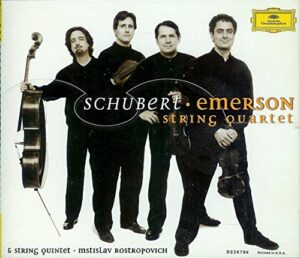 The late string quartets, String quintet / Schubert, Franz In 1990, the Emerson String Quartet recorded Schubert’s Quintet in C major D956 with one of the greatest cellists of the twentieth century, Mstislav Rostropovich (1927-2007), to be included on their CD of Schubert’s ‘late’ string quartets. For the members of the Emerson, this collaboration was the most memorable of their careers, almost overwhelmed by Rostropovich’s boundless zest for life, his idiosyncratic ideas about when and how to rehearse, and of course, his legendary musicianship. At the second rehearsal of Schubert’s Quintet in the Dreifaltigkeitskirche in the town of Speyer, David Finkel of the Emerson Quartet recalled that:
The late string quartets, String quintet / Schubert, Franz In 1990, the Emerson String Quartet recorded Schubert’s Quintet in C major D956 with one of the greatest cellists of the twentieth century, Mstislav Rostropovich (1927-2007), to be included on their CD of Schubert’s ‘late’ string quartets. For the members of the Emerson, this collaboration was the most memorable of their careers, almost overwhelmed by Rostropovich’s boundless zest for life, his idiosyncratic ideas about when and how to rehearse, and of course, his legendary musicianship. At the second rehearsal of Schubert’s Quintet in the Dreifaltigkeitskirche in the town of Speyer, David Finkel of the Emerson Quartet recalled that:
we were left in the musical dust as Slava took command of everything, summoning up metaphors, noticing details in the composition, stopping for detailed work, exhorting us to do more of just about everything we thought we were already doing. It was like being dragged by a freight train. It was exciting, exhausting, and unnerving to be playing with someone who could hear so acutely, whose understanding of the music was so deep, and whose charisma was so
overpowering.
In this recording, Rostropovich plays the 1711 ‘Duport’ Stradivarius, which was his instrument from 1974 until his death. It is likely that this is the instrument on which either Louis or Jean-Pierre Duport played Beethoven’s sonatas for the King of Prussia, with Beethoven at the piano; in the 1840s, the ‘Duport’ Stradivarius was the instrument on which August Franchomme would perform Chopin’s Cello Sonata, with Chopin playing the piano. Rostropovich would later record Chopin’s Sonata, a piece that the ‘Duport’ Stradivarius already ‘knew’. In his collaboration with the Emerson Quartet in their recording of Schubert’s Quintet in C major, the distinctive tone of Rostropovich’s cello is audible, but the ensemble is perfectly blended in a poetic interpretation of the piece.


